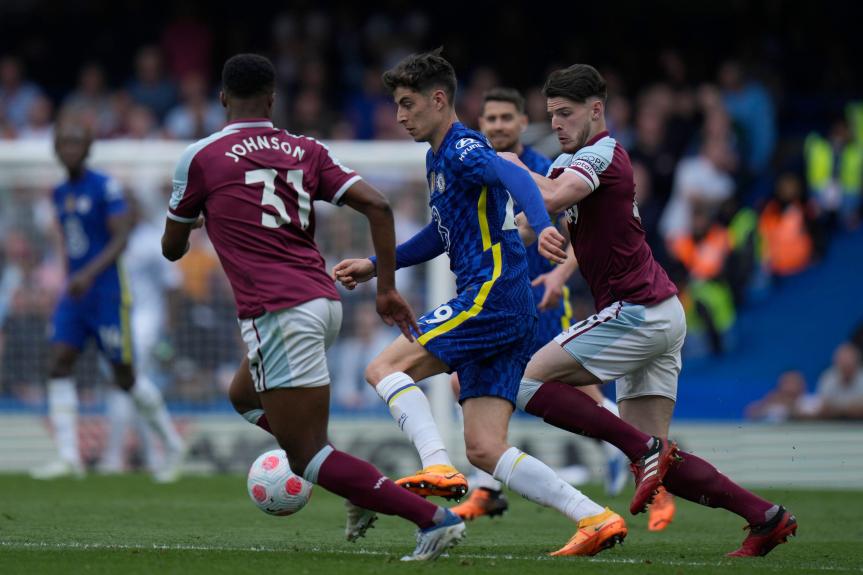BRITAIN may be on the brink of a burgeoning economic crisis that is characterised by deteriorating infrastructure, neglected schools and hospitals and the rising cost of living, but the Premier League just carries on as if it is business as normal. While so many people are struggling to make ends meet, football at the highest level continues to extend the gap between itself and reality. Last summer it was Chelsea, this year Arsenal are spending big, about to secure their first £ 100 million player and paying more than £ 60 million for a forward who needed to move to rediscover his verve. Both have come from London clubs, and in the case of West Ham’s Declan Rice, it could be the most significant inter-London transaction of all time.
In the past the big London clubs were reluctant to trade players with each other, although it was perfectly acceptable to plunder talent from the next tier, including Fulham, Crystal Palace, QPR and others. But in the case of Arsenal, Chelsea, Tottenham and West Ham, cash transfers were surprisingly rare between them. “Never sell your best players to neighbours or rivals,” said one manager back in the 1970s. There’s some logic in that statement; after all, why would any club willingly weaken itself while strengthening their main competitors? Financial crisis permitting, of course. In any climate, it would be difficult for any club to resist the temptation of cashing in on a prime asset.
It is difficult find a relevant signing by Arsenal from West Ham in their entire history. Players have gone in the other direction and there have been some loans, but generally the two clubs rarely get round the table to discuss business. One transfer that failed to deliver was John Radford’s in 1976, the double-winning Gunner was very out-of-sorts at Upton Park.
Arsenal seldom enter into transfer relationships with Tottenham, the last major deal was in 2001-02 when Sol Campbell, very controversially, moved from Spurs to Arsenal on a free. Other notables include Pat Jennings joining Arsenal in 1977-78 from Tottenham and a swap deal involving Jimmy Robertson and David Jenkins, with the former, a FA Cup final scorer in 1967, moving to Highbury.
Chelsea and Tottenham have also rarely traded on a grand scale, the last players to join Chelsea from Spurs were Micky Hazard (1985 £ 325,000) and Colin Lee (1979 £ 225,000). There have been more taking the route to Tottenham, including Gus Poyet and Gordon Durie. The most fruitful Chelsea-Tottenham deals were, arguably, the low-key transfers of Les Allen and Bobby Smith to White Hart Lane, with both players becoming part of Bill Nicholson’s double winners in 1961. Terry Venables, in 1966, found himself surplus to requirements at Stamford Bridge and was sold to Spur.
Chelsea raided West Ham on a number of occasions in the early 21st century, acquiring Frank Lampard, Joe Cole and Glen Johnson, deals that earned the Hammers close to £ 35 million when that was a significant sum of money. The biggest deal going the other way was Kurt Zouma’s £ 35 million farewell in 2021-22.
Arsenal, have, in recent years, been happy to take Chelsea players who have run their course at Stamford Bridge, including David Luiz, Willian, Peter Cech and Jorginho. Havertz is a far different story, he has mileage left in this career. Prior to this quintent, William Gallas in 2006, made the short journey from South-West to North London. Go back further, and George Graham and Tommy Baldwin exchanged employers, with the latter joining Tommy Docherty’s young side in 1966.
West Ham and Spurs have completed some notable business, the sales of Michael Carrick for £ 4.1 million in 2004-05 and Jermaine Defoe a year earlier for £ 10.5 million among the highlights. But a transaction in 1970 stole the headlines when Martin Peters, a member of England’s 1966 World Cup winners, moved to Spurs for £ 220,000 with Jimmy Greaves used as part of the deal in exchange. Greaves would bow out of the professional games in 1971, but Peters had a very durable and long career that saw him win three major trophies with Spurs.
Many players have played for more than one London club – Clive Allen, for example, turned out for QPR, Crystal Palace, Tottenham, Chelsea, West Ham and Millwall, and he was also signed by Arsenal in 1980 but after three pre-season games, was sold to Palace in exchange for Kenny Sansom. Another Palace man, Barry Silkman, a journeyman if ever there was one, also appeared for QPR, Wimbledon, Brentford and Leyton Orient. There are others.
It may be that London rivalry is not what it used to be, and that wouldn’t be surprising given the cosmopolitan nature of first team squads. The average number of foreign players in the capital’s seven Premier clubs is currently 70% and across all 12 London clubs, the figure is 59%. The top players of Arsenal, Chelsea and Tottenham could be forgiven for feeling that matches against each other are just another high-profile Premier fixture. For the fans it will always be different. But this may explain why clubs are now more open to selling to any club that can give them a good deal and for West Ham United and Chelsea, Arsenal have provided a big pay day for them, and at the same time, added some quality to their squad.

